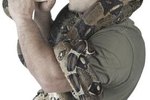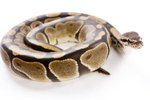
Boa constrictors are highly-rated by snake fans, and the Colombian boa constrictor is at the top of the list according to the Herp Center Network. The "constrictor imperator" species also is called the common boa, the Central American boa as well as the Colombian boa. The species is found in countries ranging from Mexico to the the northern and central regions of South America. Part of the species' popularity is due to its temperament.
Size and Weight
The adult Colombian boa typically measures six to nine feet in length, although some have been known to reach 10 feet. Females are larger than males: Clay Davenport reptile breeders suggest that males don't usually grow to more than seven feet in length. Baby boas measure about two feet at birth. The National Geographic states that boas keep growing throughout their 25- to 30-year lifespan. It also claims that the longest boa ever found measured 13 feet. The weight depends on the length, but on average a Colombian boa weighs 60 pounds. However, boas weighing up to 100 pounds are not unknown.
Temperament
One reason for this snake's popularity with enthusiasts is its calm and docile temperament. This laid-back snake is easy to handle and, as boa fan Clay Davenport suggests, the boa is unlikely to make your adrenalin levels rise during handling, despite his impressive size. His temperament makes him a good choice of pet snake for those with beginner to intermediate experience, although Davenport suggests that the boa isn't an ideal first snake because of his size. Colombian boas still are imported in the United States, but, as Davenport points out, there is a plentiful supply of boas bred in captivity in the U.S., removing the need to buy ones captured in the wild.
Care
Due to his size, the Colombian boa needs a fairly large enclosure. An adult needs a cage measuring three to six feet in length, two feet in depth and at least 18 inches high. A suitably sized aquarium tank with a locking top is appropriate. The boa's home needs heat. The Long Island Herpetological Society suggests placing a heat pad beneath the unit set to 90 degrees. Alternatively, since these snakes like climbing branches, you could provide some for him and use a suspended heat lamp. The ambient air temperature inside the enclosure should be 83 degrees in summer and 72 degrees in winter. Make sure the snake has space to get away from a direct heat source, so that he can regulate his body temperature. Provide a large bowl of water. He needs it for drinking and to help his shedding process. He also likes to soak his body in it. The water helps maintain a humid environment, but you may still have to spray mist in the enclosure every couple of days to keep it humid.
Diet
Boas in the wild live on small rodents and birds. In captivity, a diet of frozen rodents is sufficient according to the Herp Center Network. You need to thaw the frozen food before feeding it to the snake. The Herp Center Network also suggests feeding the boa moderate quantities on a regular basis rather than large amounts infrequently. Young boas under 12 months should be fed every five to seven days, while an adult boa needs to be fed only every two to four weeks. Babies can digest only small mice, but an adult needs large rabbits or rats.
References
Resources
Photo Credits
-
Ryan McVay/Digital Vision/Getty Images
Writer Bio
Based in London, Eleanor McKenzie has been writing lifestyle-related books and articles since 1998. Her articles have appeared in the "Palm Beach Times" and she is the author of numerous books published by Hamlyn U.K., including "Healing Reiki" and "Pilates System." She holds a Master of Arts in informational studies from London University.




